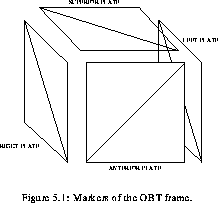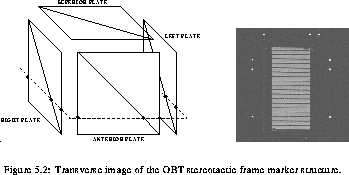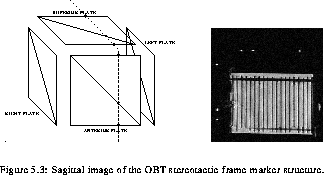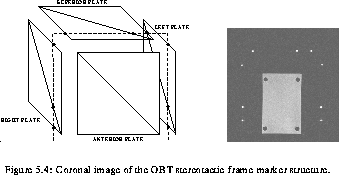



Next: Data acquisition
Up: MR geometrical distortion
Previous: MR geometrical distortion
One of the most fundamental distinctions between and
conventional stereotaxy is the use of a global 3-D transformation
between the image and surgical spaces. In conventional stereotaxy,
since the transformation is performed on a slice-by-slice basis, any
local distortion in a region of image space does not perturb the
transformation found from slices that are removed from that region.
However, in , it is important to ensure that the whole volume is
geometrically consistent in order to be able to perform reliable
registrations.
Moreover, results of simulations reported in Chapter
3 tend to demonstrate that a means of
significantly decreasing the error of registration by homologous point
matching is to use a large number of points. Because the number of
reliable natural landmarks at the surface of a patient is small, this
involves the use of some external set of fiducial markers. These
markers could be individually attached to the patient's head or could
be fixed to a rigid structure that would itself be firmly attached to
the patient's head. In any case, requires that the markers be
accurately represented in image space, i.e., that the relative
distribution of the markers as deduced from the images be the same as
the actual placements.
In order to test the geometrical accuracy of the representation in image
space of such a set of fiducial markers, the relative position of the
markers must be known precisely. Since a reference structure
specially designed for is not yet available, the OBT stereotatic
frame (OBT_frame) was employed instead.
This section describes an experiment whose goal is:
- to measure the geometrical distortion, on a 3-D MR acquisition,
of fiducial markers associated with the stereotactic frame and
- to investigate the effect of the image acquisition protocol on
the geometry of that structure.
The marker structures visible on MR images of the OBT frame are
CuSO solution filled channels embedded in plastic plates.
Although only four plates were used for the experiment, the frame can
accommodate five, and in each of them, four linear channels form a
perfect square (of 130 mm on a side) with a fifth channel joining
opposite corners of this square. The plates can be fixed on the frame
at precise positions. frameplates shows the 3-D structure
(whose geometry is known to within
solution filled channels embedded in plastic plates.
Although only four plates were used for the experiment, the frame can
accommodate five, and in each of them, four linear channels form a
perfect square (of 130 mm on a side) with a fifth channel joining
opposite corners of this square. The plates can be fixed on the frame
at precise positions. frameplates shows the 3-D structure
(whose geometry is known to within  0.1 mm) formed by the markers
when the plates are mounted on the frame.
0.1 mm) formed by the markers
when the plates are mounted on the frame.

In MRI, it is possible to acquire a volume as a whole in one single
acquisition (as distinct from 2-D imaging where the volume consists of
a stack of 2-D images). This is achieved by manipulating the spin
distribution using three orthogonal gradients in such a way that each
sample of the MR signal corresponds to a point in a 3-D Fourier space
(k-space). Note that unlike 2-D MRI where only one slice is excited
at each RF pulse, the signal in 3-D MRI comes from all the spins in
the volume. As in 2-D Fourier MRI, one of the gradients is turned on
during the readout of the signal. This gradient is referred to as
frequency encoding or readout gradient. The two
other gradients are called phase encoding gradients.
Although in 3-D imaging, since the data are acquired as a volume, the
concept of slice is rather imprecise, and it is conventional to define
the acquisition plane as the plane formed by the frequency
encoding gradient and the phase encoding gradient that changes the
most rapidly. Typically, the orientation can be transverse (x-y
plane), sagittal (y-z plane) or coronal (x-z plane), were x
increases from left to right, y increases from anterior to posterior
and z increases from inferior to superior (with respect to a patient
lying supine in the scanner). This convention also defines the
orientation of the plane that peels from the 3-D data block most
readily, i.e., where data elements constitute a linear vector in
computer memory.
Independently of the acquisition plane, the 3-D data can be viewed in
any of these planes. trans_framecor_frame illustrate
the different slice orientations with respect to the stereotactic
marker structure and the appearance of the image for each case. The
phantom that appears in these images was not used in the analysis, but
provided a convenient way to support the frame and simulated the level
of the MR signal encountered in practice.



The four corners of the squares formed by the markers in each plate
constitute points that are easily localized on the image. Moreover, the
position of these corners on the images can be found by fitting
straight lines on each linear channel followed by finding the intersection
point of the lines found in this manner.




Next: Data acquisition
Up: MR geometrical distortion
Previous: MR geometrical distortion
Patrice MUNGER
Mon Oct 23 15:09:17 EDT 1995
 solution filled channels embedded in plastic plates.
Although only four plates were used for the experiment, the frame can
accommodate five, and in each of them, four linear channels form a
perfect square (of 130 mm on a side) with a fifth channel joining
opposite corners of this square. The plates can be fixed on the frame
at precise positions. frameplates shows the 3-D structure
(whose geometry is known to within
solution filled channels embedded in plastic plates.
Although only four plates were used for the experiment, the frame can
accommodate five, and in each of them, four linear channels form a
perfect square (of 130 mm on a side) with a fifth channel joining
opposite corners of this square. The plates can be fixed on the frame
at precise positions. frameplates shows the 3-D structure
(whose geometry is known to within  0.1 mm) formed by the markers
when the plates are mounted on the frame.
0.1 mm) formed by the markers
when the plates are mounted on the frame.



